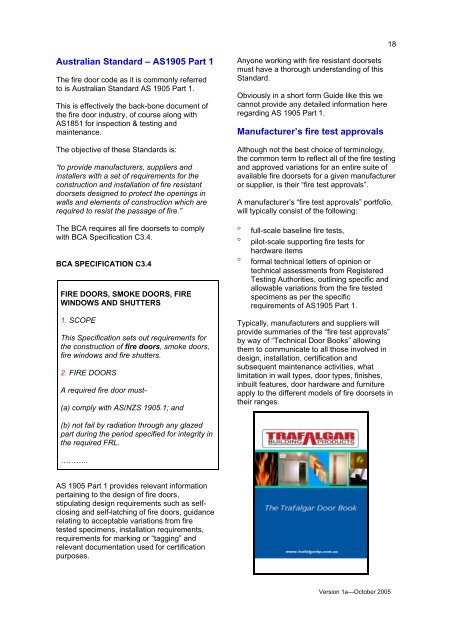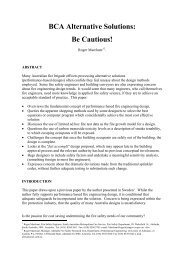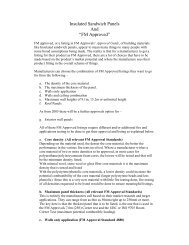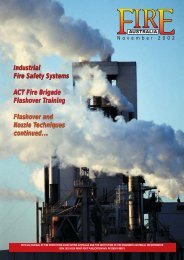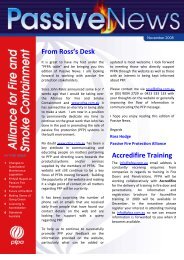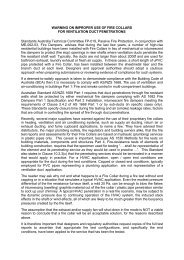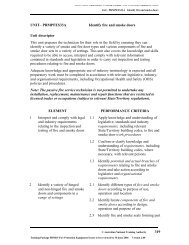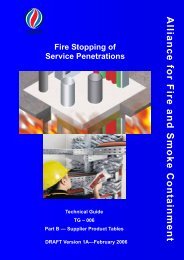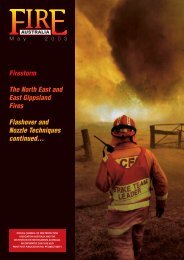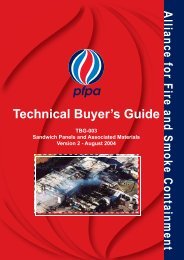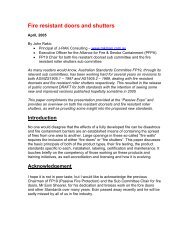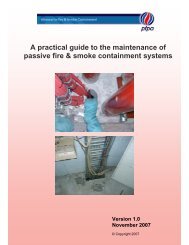Containment
Fire Doors and Fire Door Hardware_v1a.pdf - PFPA
Fire Doors and Fire Door Hardware_v1a.pdf - PFPA
- No tags were found...
Create successful ePaper yourself
Turn your PDF publications into a flip-book with our unique Google optimized e-Paper software.
18<br />
Australian Standard – AS1905 Part 1<br />
The fire door code as it is commonly referred<br />
to is Australian Standard AS 1905 Part 1.<br />
This is effectively the back-bone document of<br />
the fire door industry, of course along with<br />
AS1851 for inspection & testing and<br />
maintenance.<br />
The objective of these Standards is:<br />
“to provide manufacturers, suppliers and<br />
installers with a set of requirements for the<br />
construction and installation of fire resistant<br />
doorsets designed to protect the openings in<br />
walls and elements of construction which are<br />
required to resist the passage of fire.”<br />
The BCA requires all fire doorsets to comply<br />
with BCA Specification C3.4.<br />
BCA SPECIFICATION C3.4<br />
FIRE DOORS, SMOKE DOORS, FIRE<br />
WINDOWS AND SHUTTERS<br />
1. SCOPE<br />
This Specification sets out requirements for<br />
the construction of fire doors, smoke doors,<br />
fire windows and fire shutters.<br />
2. FIRE DOORS<br />
A required fire door must-<br />
(a) comply with AS/NZS 1905.1; and<br />
Anyone working with fire resistant doorsets<br />
must have a thorough understanding of this<br />
Standard.<br />
Obviously in a short form Guide like this we<br />
cannot provide any detailed information here<br />
regarding AS 1905 Part 1.<br />
Manufacturer’s fire test approvals<br />
Although not the best choice of terminology,<br />
the common term to reflect all of the fire testing<br />
and approved variations for an entire suite of<br />
available fire doorsets for a given manufacturer<br />
or supplier, is their “fire test approvals”.<br />
A manufacturer’s “fire test approvals” portfolio,<br />
will typically consist of the following:<br />
° full-scale baseline fire tests,<br />
° pilot-scale supporting fire tests for<br />
hardware items<br />
° formal technical letters of opinion or<br />
technical assessments from Registered<br />
Testing Authorities, outlining specific and<br />
allowable variations from the fire tested<br />
specimens as per the specific<br />
requirements of AS1905 Part 1.<br />
Typically, manufacturers and suppliers will<br />
provide summaries of the “fire test approvals”<br />
by way of “Technical Door Books” allowing<br />
them to communicate to all those involved in<br />
design, installation, certification and<br />
subsequent maintenance activities, what<br />
limitation in wall types, door types, finishes,<br />
inbuilt features, door hardware and furniture<br />
apply to the different models of fire doorsets in<br />
their ranges.<br />
(b) not fail by radiation through any glazed<br />
part during the period specified for integrity in<br />
the required FRL.<br />
………..<br />
AS 1905 Part 1 provides relevant information<br />
pertaining to the design of fire doors,<br />
stipulating design requirements such as selfclosing<br />
and self-latching of fire doors, guidance<br />
relating to acceptable variations from fire<br />
tested specimens, installation requirements,<br />
requirements for marking or “tagging” and<br />
relevant documentation used for certification<br />
purposes.<br />
Version 1a—October 2005


